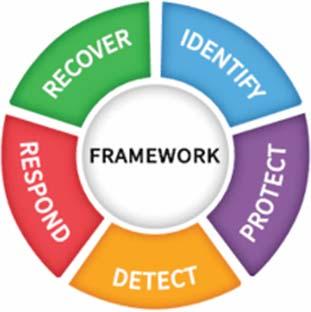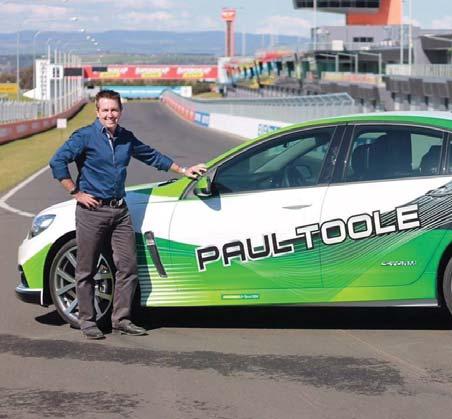
12 minute read
RECRUITMENT
DARRYL MCALLISTER
Advertisement
NOT all IT service providers stress security as much as they need to. This not only leaves their own firm at risk – it can leave their customers at risk as well.
Th e old adage: “Th e cobbler’s kids must have the best shoes” comes into play when you choose someone to trust with your information security. If your IT provider is making cybersecurity a top priority in the way they conduct business, then you know that when they handle your technology services, you’re going to be among the best-protected of Sydney businesses.
What risks are involved with choosing the wrong IT Support Provider that doesn’t stress security? NetCare subscribe on an ongoing basis to the resources of TruMethods – the leading US-based company providing cybersecurity advice to IT Services Providers – and their recent survey revealed the following alarming results: • 74% of IT Support Providers have been the victim of a cyber-attack. • 67% of IT Support Providers don’t feel fully confident in their ability to defend customers against an attack. • 92% of SMBs see cybersecurity as a priority and will pay more for it. • 74% of SMBs that use an IT
Support Provider would take legal action against them in the event of an attack.
At NetCare, we take cybersecurity very seriously – in fact, the essence of our business is to be a Security-First IT Services Provider.
We understand that how securely we

run our own technology infrastructure has a direct impact on our customers' cybersecurity posture.
In 2018, a large-scale hack by two foreign nationals stole intellectual property from multiple American organisations. However, they didn’t do it by hacking into those companies, they did it by infi ltrating their IT Service Providers. Once the providers had been breached, the hackers were able to move within their network of customers, secretly exfi ltrating data over the course of several months.
Does your current IT Support Provider put security fi rst? Do they believe that security is a journey, not a destination?
Keep Up to Date on Cyber Security News
In early August of this year, the Prime Minister of Australia announced the country's 2020 Cyber Security Strategy. Th is includes an investment of AU$1.67 billion to build new cybersecurity and law enforcement capabilities. Th e strategy also stresses that “cyber security is a fundamental part of everyday life.”
Th is is an example of the types of industry news and events related to IT security that we keep track of so we can bett er inform and service our clients. Indeed, we're a registered Partner of the Australian Cyber Security Centre (ACSC), a department within the Australian Signals Directorate.
A few of the features of this new Government strategy are: • Expand efforts to raise awareness of cybersecurity threats and drive uptake of safe and secure online behaviors across the community. • Expand 24/7 cyber security advice hotline for families and older Australians.
• Increase funding for victim support. • Introduce a voluntary Internet of Things Code of Practice to help consumers make informed purchasing decisions.
Implement NIST Cybersecurity Best Practices
Th e NIST Cybersecurity Framework is our primary security focus in our NetCare Technology Success process. Th is includes following the guidelines of the US National Cybersecurity Center of Excellence (NCCoE) at the National Institute of Standards and Technology (NIST).
Th ese guidelines are designed for Security-First IT Service Providers to improve their own cybersecurity as well as the cybersecurity of their customers.
Th e NIST Cybersecurity Framework incorporates a set of core IT security functions with categories and sub-categories of activities to follow for each one.
It takes a layered approach to reduce risk by implementing multiple protections together.
Th e fi ve core areas of the NIST Cybersecurity Framework include: • Identify: Activities in this area include developing an understanding of organisational risk and creating systems to mitigate the risk and prioritise IT security strategies. • Protect: Th is includes the development of protective safeguards, including things like data security, awareness training, identity management, and more. • Detect: Th e detect area of the NIST Framework includes activities designed to identify the occurrence of a cybersecurity event. Th is can include continuous monitoring and soft ware that is designed to seek out anomalies.
• Respond: Functions such as disaster recovery, communications, and response planning are included in this area of the Framework. • Recover: Th e recovery area includes the ability to remain resilient in the aft ermath of a cyberatt ack and can include recovery planning and ongoing improvements.
By basing our own IT security as well as that of our customers on the NIST Cybersecurity Framework, we ensure that no stone is left unturned when it comes to continually improving our cybersecurity defence strategy on behalf of our customers.

Learn More About Improving Your IT Security
Is your IT support provider using the NIST Cybersecurity Framework? Or are they one of those 67% that lack confi dence that they can defend customers from an att ack? Sleep easier at night by working with an IT Services Provider that puts security fi rst.
Darryl McAllister is MD at Netwcare. Visit www. netcare.net.au


Western Sydney’s most sought-after business publication

inside



ravelACCESSTACCESS September 2020 Digital edition: www.issuu.com/accessnews Edited by DALLAS SHERRINGHAM We’re in the Business of Travel
Shock plans will revive old project
A tunnel to the Emerald City
DALLAS SHERRINGHAM
IF you know where to look on the Great Western Hwy between Orange and Bathurst there is a crossroads lying in a sleepy hollow near the Beekeepers Inn hotel.
Not many stop for a beer or to quickly stretch the legs. If you listen, you might hear the sounds of the currawongs on a crisp morning, but things could have been oh so diff erent if Vitt oria had become the CBD for a brand new super city unveiled in the 1970s.
You see, Australia was a diff erent place back in 1975. We looked outward, not inward.
I went there to report on the new “wonder centre of Australia” for a daily newspaper and dubbed it the Emerald City because of the green fi elds and trees.
An inter-city rapid transit rail line was planned between Orange and Bathurst via the new city at Vitt oria, when planners in 1975 envisioned the Central West as the fi rst Super City region
It would feature Orange with a population of 60,000 people, Bathurst with 50,000 and Blayney with 10,000 but all were dwarfed by super city in the middle at Vitt oria with 110,000 residents.
Th at is what State Government planners in 1975 saw how the Central West would look today.
Th e Bathurst/Orange Growth Area plan was created in the 1970s as part of a major decentralisation plan, along with the Albury/Wodonga region, to sett le people away from Sydney.
Prime Minister Gough Whitlam grew up in Canberra and understood the need to build great new cities in inland Australia; cities that would be planned by the government from the fi rst shovel of dirt onwards.
Originally it was proposed the whole region would be home to 300,000 people but that was later reduced to 240,000. Today the population is about 100,000.
It was proposed to create a road network similar to the one operating in Canberra.
A report into the project said the region was selected to be the fi rst growth centre in NSW because of its proximity to Sydney, a central location, excellent road and rail links, plenty of natural resources for construction work, access to natural gas and land that stretched on forever.

Gough Whitlam's outlook on the planning and development of Australia's cities was shaped by his experience of having grown up in Canberra – the only Australian city whose development was guided by a single level of government. Th is instilled in him a fi rm belief in the capacity of the Federal government to provide the resources and organising authority to resolve the urban problems that aff ected the living standards and opportunities of Australians most severely. Later, raising a family in Sydney's rapidly growing western suburbs gave Mr Whitlam direct experience of the consequences of poor investment in the infrastructure and services people needed in these new residential areas.
How it all came about and then didn’t come about is the stuff of legends.
Continued on page 35
Don’t put the FREEZE on your business meetings.
Plan for success this winter. Day Delegate Package
Winter bonus includes: • FREE WiFi • FREE 30 minute post event drinks in rebellion bar • FREE delicious delight on arrival

To book your next event, email: functions_rydgesnorwest@evt.com or call 02 9634 9634
Rydges Norwest Sydney
1 Columbia Court, Baulkham Hills NSW 2153 T: 02 9634 9634 F: 02 9634 9660
rydges.com/norwest $60
per person
Continued from page 34
Flash Forward 50 years
Flash forward almost 50 years and Government is again looking at opportunities to extend Western Sydney into the Bathurst area and beyond.
Th e State's Regional Roads and Transport Minister Paul Toole fl oated the idea of "looking at costings" for a tunnel or series of tunnels under the Blue Mountains, connecting Penrith and Lithgow.
Th e Coalition Government has committ ed to a $2.5billion, 31km duplication of the Great Western Hwy between Lithgow and Katoomba.
But the Member for Bathurst Mr Toole said he would also use the next three years to start planning the next stage of upgrades to the pivotal Orange-to-Sydney route.
‘It's a big job but, who knows, if the Feds come on board and give us some real money then maybe we can expedite it even faster than that,” Mr Toole said. "What I want is a safe and fast road from Lithgow to Penrith where you can travel at 100km/h because one of the real frustrations at the moment are all the speed limit changes," he said. "When you get to towns like Blackheath, though, you really can't go around so the only way is to go under so we want to start looking at costings for tunnels in the next four years.”
Th e call came aft er a big win at the state election when he defi ed a statewide swing against the Nationals and just days aft er he became Deputy Leader of the NSW Nationals.
Th e upgrade of the highway through the Blue Mountains hit a speed bump as local politicians and residents condemned the state government's proposal for a bypass around Blackheath.
Th e upgrade of the Great Western Highway is intended to improve safety and remove congestion from Blue Mountains towns such as Blackheath.
However, Blue Mountains City Council went so far as to call on the State Government to abandon plans to duplicate the highway because of "grave concerns" about the destruction of native bushland, acquisition of homes and impacts on towns.
Blackheath is just one of several mountains towns and villages worried about their future.
Juliet Bourke, chairwoman of community-based Save Centennial Glen, said residents supported the upgrade of the highway to improve road safety but did not want it to destroy the environment and ruin the town's village atmosphere.
Ms Bourke is a supporter of the long tunnels plan and said there was strong support for a long tunnel under Blackheath. "No homes would be destroyed and stacks would not be required because the portals would be outside the main area of Blackheath," she said. "It would enhance safety and livability and have minimal impact on the environment."
Removing traffic congestion
Transport for NSW western region director Alistair Lunn said the plan was designed to improve safety and remove congestion. "Th e upgrade will remove through and heavy traffi c from bypassed villages, return local roads to the community and create growth opportunities for businesses and tourism as well as signifi cant jobs during construction," he said.
“One of the key sticking points is how to preserve the character of Blackheath and other mountain villages. Removing through and heavy traffi c as much as possible is at the heart of this plan,

Mr Lunn said. "Th e road upgrade will not impact on the Blue Mountains World Heritage area."
But Ms Bourke does not agree. "Th is is an area of sanctuary for wildlife, especially aft er the fi res on the eastern side of Blackheath in summer and is home to vulnerable and endangered fl ora and fauna." said.
Mr Lunn said a committ ee of community representatives, emergency services and transport bureaucrats had formed to inform the best road design through Blackheath.
But Ms Bourke, who sits on the committ ee, said: "It would make a mockery of this 'co-design' process if the minister were to ignore our preference and implement something we are categorically against."
Whatever happens, NSW holds the record for the world’s longest road tunnel with Westconnex at 23km.
If a tunnel was built under the mountains it would be twice that length but we have the expertise and machines to do it quite quickly through the sandstone base of the mountains..
And when its fi nished, a Bathurst resident could drive to work in Western Sydney in less than 1.5hours.
Th e tunnel would also do wonders for struggling towns further west such as Wellington, Dubbo Parkes and Mudgee who all suff er from the tyranny of the shocking 19th century style roads over the Great Divide.
No doubt the tunnel will happen one day as Sydney bursts at the seams, but it should also include an adjacent rapid transport rail system operating “bullet trains”. Th is would connect with the Brisbane to Melbourne line near Dubbo.
On that system, a commuter from Dubbo would be in Western Sydney in just over an hour.
Until then, the Emerald City, will be but a dream gathering dust on a shelf somewhere. And the currawong’s morning chorus will be the only sound you hear.












